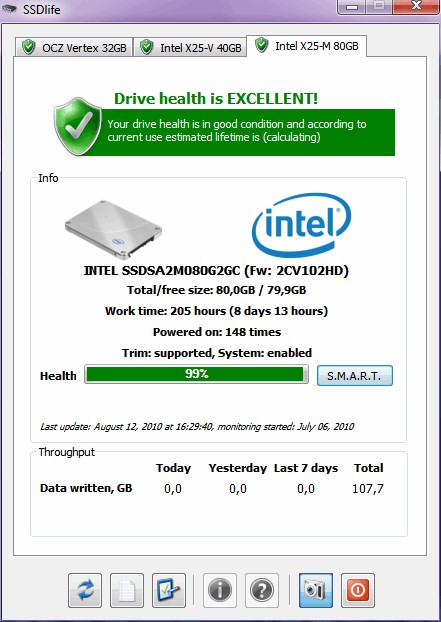

- #Linux ssd health install#
- #Linux ssd health software#
- #Linux ssd health plus#
- #Linux ssd health series#
To Start Smartmontools service, execute the below command: $ sudo /etc/init.d/smartmontools start
#Linux ssd health install#
To install smartmontools in Linux, run the below command: $ sudo apt install smartmontools Smartmontools is available by default in all Linux distributions including Ubuntu, RHEL and Centos and Fedora. Smartmontools helps you keep an eye on the health of your hard disk and SSD drives. I actually ran the SSD on a SATA 2 port due to my R9 290x blocking the SATA 3 por.

#Linux ssd health plus#
Smartctl utility tool comes with the package smartmontools. So after downloading and installing Hard Drive Sentinel I found out both my used hard drives are at 100 health and functionality but the Sandisk SSD Plus that I bought new was at 20 health, but 100 functionality. It can be used to check hard disk, SAS disk, SSD and also check disk on raid conroller such as HP Smart Array controller, LSI Megaraid Dell PERC. Install smartmontools package for your system. Smartmontools is open source tools to check your disk health. Steps to check hard drive health status in Linux: Launch terminal.
#Linux ssd health software#
This software is not compatible with other manufacturers SSDs. Disk errors such as bad sectors or corrupted filesystems are not covered by S.M.A.R.T., thus requiring other methods to check. It’s not 100 percent accurate at predicting imminent drive failure, so, as you should always do, keep current backups. SMART is the Self-Monitoring, Analysis and Reporting Technology built-in to modern drives, and smartmontools reads the SMART data.

#Linux ssd health series#
Smartctl is a command-line utility tool that can be used to check S.M.A.R.T-enabled HDD or SSD status in the Linux system. Samsung Magician Software for Consumer SSD (3) The Magician SSD management utility is designed to work with all Samsung SSD products including 470 Series, 750 Series, 830 Series, 840 Series, 850 Series, 860 Series, 870 Series, 960 Series, 970 Series and 980 Series. Smartmontools helps you keep an eye on the health of your hard disk and SSD drives. It also allows you to perform on-demand tests on the drive. S.M.A.R.T is a tool used to monitor the health status of SSD and HDD. It will help you to identify failed drives and they can be replaced before any data loss occurs. Then, it is recommended to check the health of the SSD and HDD drives regularly. If you are a system administrator and responsible for managing Linux systems in Datacenter. This is a part of the smartmontools package, which. What is the need to check Linux system SSD and HDD drives ? Disk errors such as bad sectors or corrupted filesystems are not covered by S.M.A.R.T., thus requiring other methods to check. If youre running Linux, the simplest way to check SSD health is through to the command line tool smartctl. 2 hours ago GSmartControl Tool to Check SSD/HDD Health on Linux. It checks different drive attributes to detect the possibility of drive failure. Tool to Check SSD/HDD Health on Linux GeeksforGeeks. In fact, SMART (Self-Monitoring, Analysis, and Reporting Technology) is a feature enabled in all modern hard disk drives and SSDs to monitor/test reliability. This article covers the different ways to check the health of your Hard Disk Drives and Solid-State Drives. SSDLife has been tested with solid-state drives from most SSD manufacturers – such as Kingston, OCZ.Check your HDD / SSD Health in Ubuntu 20.04 - The best way ? SSDLife supports practically all SSDs that are in use – from the latest Intel models to the time-proven first Vertex models. Sometimes you may need it to find out how many hours the drive has already been in operation, for example, when you buy a used SSD. The entire information about your SSD - from general (manufacturer, model) to technical (whether your drive/system supports TRIM) - is displayed in the main window of SSD Life. Of course, the date of the lifetime expiration is corrected depending on how intensively you keep using your drive. SSD Life analyzes how actively you use your solid-state drive and uses a special algorithm to calculate its estimated lifetime. You can just click on it and it will get you to the table. In the get log page command, if you go down here, theres smart health information. If you go into the NVMe spec, and again, just now on the latest one, theres a get log page command. SSDLife allows you to control how worn your SSDs are in an easy and convenient way, which means you can control how safely and securely your data is stored on them. Now this bit, if you go look into the NVMe SSD spec, you can go in here. It’s a shame when a drive failure results in all your personal data being lost.


 0 kommentar(er)
0 kommentar(er)
